Design Politics of Election Devices
Lucas Teixeira Vaqueiro
One of the most bizarre aspects of telecommuting during the pandemic is being physically in one place while virtually bonded to another. I am located in the city of São Paulo, in southeast Brazil. I live under Brazilian law, use the real as my currency, speak Portuguese, adhere to the UTC-3 time zone, and even work for the local government. However, every day I turn on my computer and sign in to a class held in New York City. Suddenly, my clock switches to Eastern Time, the language I use changes to English, American themes are dominant, my tuition is charged in dollars, and I am dismissed from class to celebrate Thanksgiving.
Living with daily tele-travels is a daunting task, akin to having everlasting jet-lag. Even though the migraine from my daily time zone operations persists, this last November my two localities mirrored each other in one way aside from the COVID-19 outbreak; elections were held both in Brazil and in the United States 12 days apart. As I obsessively followed the aftermath of the US General Elections, I also prepared myself for the Brazilian Party of Democracy General Elections, I also prepared myself for the Brazilian Party of Democracy (how Election Day is commonly and humorously known) on the 15th. I spent nights waiting to see if Arizona would flip while simultaneously keeping track of São Paulo’s mayoral debates. I wanted to celebrate the results from the United States as much as I wanted to vote for my candidates running for City Council. As my obsession and excitement grew, I started mixing the two elections in my head by counting how many delegates each district of São Paulo would have in my imaginary Electoral College.
While Brazil and the United States are among the biggest democracies on the planet, both countries are organized into very different electoral systems.1 On a typical Brazilian election Sunday, I would wake up, take my voter registration card alongside an official ID, write my candidates’ numbers on a piece of notepaper, attach some stickers from the candidates I support to my shirt, and walk to my polling place: the nearest school. Once there, I would follow the wayfinding cues to my designated section, where a poll worker would check my identification in the poll book and enter a code into the electrical terminal. When my turn comes, I enter the booth, type my candidates’ numbers into the electronic voting machine (first for the legislative branch, then for the executive branch), and press the green “confirm” key to finish. The process ends in a matter of seconds with a pleasant symphony of beeps to signal my votes have been cast. The poll worker detaches and hands me a slip from the poll book as proof of attendance. Around the end of the day, I would gather with some friends to follow the election results on TV and the official website from the Electoral Justice—the specialized branch of the Judiciary that constitutionally organizes the Brazilian elections.2 The polls close at 5pm BRT, and by 9pm BRT the votes are tallied and a winner declared.
I share this story not to draw a universal picture of the Brazilian voting experience. I live in a wealthy neighborhood in a large city, I am white and educated, and I follow the political debates. I share this anecdote to demonstrate how elections are performed as an assemblage of things, people, and places capable of action wherever they take place. The ritual’s scripting takes the form of an Electoral Code that dictates when, where, and how the elections occur. Schools and other public sites serve as stages, while multiple actors including pollsters, candidates, voters, citizens, and sometimes even internationally distinguished guests, play out their assigned roles alongside many objects which mediate these interactions. Registration cards, stickers, cheat sheets, wayfinding, poll books, polling booths, voting machines, government websites, ballots, and official election mail make up the material culture of democracy. By looking at these systems of human and nonhuman actors beyond their mundane verve, we can unveil the values of democracy in place—the many complex ballot designs in the United States are the material representation of a convoluted electoral modeling.3 Furthermore, by treating these artifacts as mediators, we may understand how they transform, translate, distort and modify the meaning of the ideals they comprise and the actors in interaction with them.4 I was made a voter by these artifacts; I am as much designed as is a ballot.
In the production of elections, as well as in other occasions, design and politics are set aside. Whereas designing a ballot is meant to be prosaic, organizing elections is inherently political. Nonetheless, I am particularly drawn to the idea of “design politics” introduced by Mahmoud Keshavarz while analyzing the passport. Keshavarz challenges this separation arguing that politics always has material understanding and design is always a political activity by transforming, reappropriating, and reworking these materialities.5 As much as elections are socially constructed, they are materially sustained and reproduced by objects that are carefully chosen from limitless possibilities. The seemingly undramatic practice of designing a ballot by election officials, lawyers, typesetters, printers, or any other “technocrat” manifest both social values and wills into materials, and it articulates the relationship between various artifacts, people, and spaces within the electoral system.6
The Brazilian and the US electoral systems differ in many ways, among them direct voting versus the Electoral College, centralization versus state liberty, open-list proportional versus first-past-the-post. These differences are also materialized in the use of specific artifacts generated by state and non-state actors in each country (e.g., one single electronic voting machine in the case of Brazil versus a myriad of different ballots and machines in the US). As these electoral devices were designed for different contexts with their own intentions, they articulate social and political histories and mediate the experience of voting, and therefore citizenship rights, in the two largest democracies in the Americas.
While the elections unfolded in Brazil, the differences and absence of some voting devices I am familiar with in the United States piqued my curiosity—particularly, the attention given to absentee ballots, voter registration, and paper voting. Wondering if Brazil’s rich electoral history would reveal something about these articulations between design and politics, I explored the photographic digital archive from the Brazilian Electoral Justice, reviewed political science literature, and reconsidered my personal voting experiences, particularly focusing on the objects that make me a voter. The following sections explore the design politics of three Brazilian electoral devices: the voter registration title, the official ballot, and the electronic voting machine. These artifacts were selected from different periods of Brazilian history as recording devices that illustrate how the design of electoral devices creates, mediates, and disciplines citizens and voters in this democratic ritual, whether in the moment of registering, voting, or vote tallying.
The Voter Registration Title
The first device I want to comment on is the voter registration title—the document that, beyond attesting to enlistment, creates voters by enabling specific bodies to exercise the right to vote. Introduced in the Brazilian Empire in 1875 and re-edited in 1881,7 the document was the size of a notebook (it was detached from an archival book at the moment of issuance), with Empire’s coat of arms and title covering a quarter of it. (Fig. 1) An extravagance that might seem outdated in current times, but considering Brazil’s newly declared independence, these graphics were essential to creating the identity of the newborn nation. The letterhead featured blank sections to be filled with one’s electoral district, parish, name, occupation, marital status, income, address, eligibility, and literacy status. This information was needed in order to assess Brazil’s suffrage requirements. Voters had to be men, at least 25 years old, and meet a certain income threshold. Priests had no age requirements.

Figure 1. Title issued in 1881. Courtesy of Tribunal Superior Eleitoral Archive.
Until 1842, voter registration was done at the local level in the very moment of polling after Mass. Each parish’s election board identified eligible voters and all kinds of fraud occurred (e.g., one person would vote in many neighboring parishes, voting on behalf of someone was common).8 After 1842, a parish junta was responsible for identifying and registering voters in advance, however no proof of enlisting was provided. The identification of those able to vote was still a responsibility of the election board the moment were given automatically to all eligible voters, which changed in 1881 when voter registration became more strict and further proof of eligibility was required before issuing the document. While the issuance of a title was meant to reduce fraudulent activity, the artifact did not stop it from happening. Instead, it updated how the fraud was committed. One of the most common practices was pretending to be a deceased or sick registered citizen to vote on their behalf. Sometimes two people showed up feigning to be the absentee, so the one with the most credible proof of identity and best speech ability to convince the parish board would cast the vote.9 Today, the voter registration title is now in its ninth version as a more compact and cheaper card and a smartphone app utilizing biometrics to enable verification with fingerprints in some cases.10 (Fig. 2)
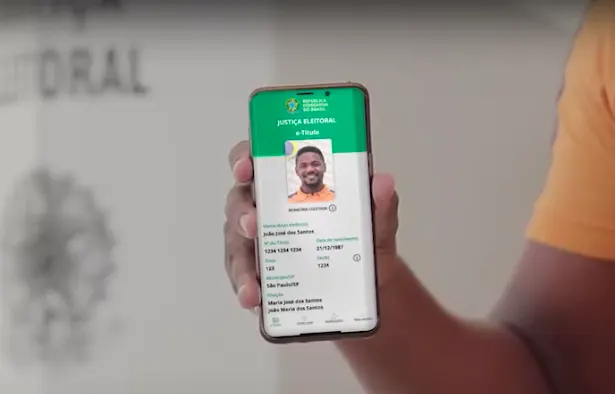
Figure 2. The Electronic Electoral Title contains the voter’s biometric information. It was popular in the 2020 Elections because a QR code allowed contactless verification for poll workers. Courtesy of TSE/Divulgação.
This election device shows how artifacts can both be tools for suffrage and evidence of discrimination. Without bearing the registration title, a person is no longer a voter, and they are unable to play any part in the electoral process. The document works similarly to Keshavarz’s passport example: It incorporates abstract values of citizenship, dictates which bodies are worthy of political will, and restrains rights like voting or social mobility. A seemingly mundane design decision to require a photograph for the registration title, as was the case from 1956–1986, had consequences on the performance of different people’s bodies, welcoming some to enact active citizenship while disenfranchising others who could not afford the cost to provide a photo or travel to the designated enrollment facility.11 (Fig. 3)
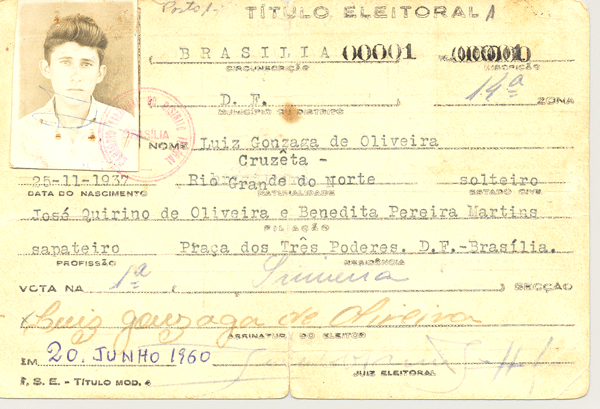
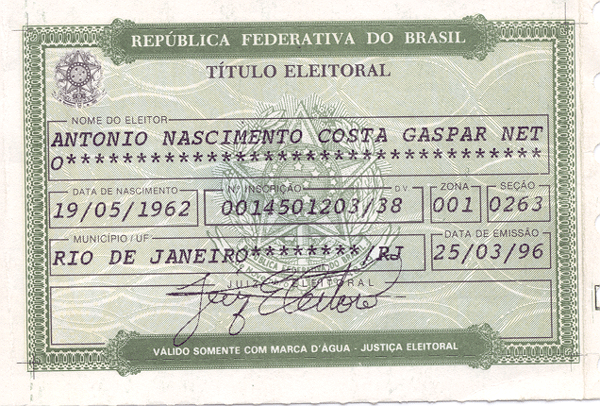
Figure 3. Top: Eighth design for the title issued in 1957. Voters were requested to submit a photograph to restrain fraud which increased the cost of registering. Courtesy of Tribunal Superior Eleitoral Archive. Bottom: The current title with no photograph was introduced in 1986 in the context of re-democratization, at a time when enlisting a vast number of voters in Brazil was a priority. Courtesy of Tribunal Superior Eleitoral Archive.
The registration title had its own life and produced new realities beyond the designer’s intentions, as shown in the previous example where people would compete to see who better fit the description provided on a letterhead. As time went by, new features were added to tame the device (e.g., photos, modes of issuance, collective enlistment by third parties, and sanctions), but keeping it dubious was also a strategy to make more voters and therefore win elections.According to Fernando Limongi, between 1945 and 1964, Brazilian political parties disputed over voters, not over votes.12 In a context of competitive elections, the process of making voters (that is, registering voters and ensuring they will cast the right vote) is fundamental to a candidate’s success. As electoral reforms led to new designs for registration artifacts and strategies, politicians created a scenario where the boundaries of political citizenship were ambiguous, fluid, and undefined with their negotiated extension periods for old documents, legal loopholes, lack of enforcement, and relaxed registration paperwork.13 Here lies the importance of the registration cards—independent of constitution or legislation, the bearing of a title allowed a certain performance of the bodies and the birth of “voting creatures.”14
The Official Ballot
The registration title is the main artifact that embodies the creation of a voter, but it was not the only one to guarantee that the creatures they gave life to would cast the the right vote. Throughout the 20th century, local vote brokers (coronéis) mastered the entrapment process of making creatures that would vote as they pleased. Apart from enlisting, coronéis provided transportation to the polls, food, drinks, entertainment, and, most insidiously, the correct ballots to cast.15 (Fig. 4) Furthermore, to ensure compliance, henchmen would follow and supervise the newly made voters to make sure they would enter the ballots they were given. Ballots are the fundamental instrument of democracy in the modern world and their design and distribution were part of the coronéis’ menu of undue electoral strategies. These ephemeral pieces of paper embody the values, enable suffrage, and create voters and representatives.16 I will focus on the 1955 adoption of the Australian ballot model as the official ballot in Brazil.17

Figure 4. Ballot printed by Partido Social Democrático for Gustavo Capanema, candidate for Congress in the 1945 elections. Courtesy of Tribunal Superior Eleitoral Archive.
Before the 1955 reforms, voters took completed, typed ballots for each candidate voted for to the polling stations. Newspapers, printed ballots, and voters themselves could craft their own, but in practice, political parties assumed the responsibility for printing and distributing ballots on a large scale, which they considered a civic duty. Even though the state did not distribute ballots, federal regulation defined their print layout. as rectangular, white, typed, and small enough to fit inside an official envelope given at the polling place.18 The ballots were required to show the representative office up for election and the name alongside the political party of the chosen candidate. Although vote secrecy had been introduced in 1875, polling was oftentimes a semi-public act due to the way ballots were made and distributed. Political parties would even give a colored envelope to conveniently monitor the votes.19 This practice was not limited to Brazil. Research by Alicia Chang shows how US elections throughout the 19th and beginning of the 20th century had flamboyant ballots usually printed by the candidates’ parties, using special typography, diverse printing techniques, different colors, and even cartoons and other drawings.20 In both examples, it is clear how the design of ballots and their envelopes had political consequences, facilitating the control of voters’ actions and hampering their freedom to choose a candidate.
The mid-20th century inaugurated a period of mass democracy and competitive elections (where there is uncertainty about a poll’s outcome). The expansion of voting rights to women and youth, the establishment of the Electoral Justice as well as the ambiguous political citizenship mentioned in the previous section made the electorate grow quickly.21 During this period, three national parties emerged to form a system that lasted throughout the Fourth Brazilian Republic from 1946 to 1964: UDN (National Democratic Union), PSD (Social Democratic Party), and PTB (Brazilian Labour Party). PSD was the main party of the period, granting parliamentary majorities and state governments from successive electoral victories. The party was flexible, centrist, focused on governance, and able to sustain a balance of modern and conservative practices. This ability was its biggest asset as it enabled the party to master the process of making voters due to the incorporation of local oligarchies and their coronéis.22
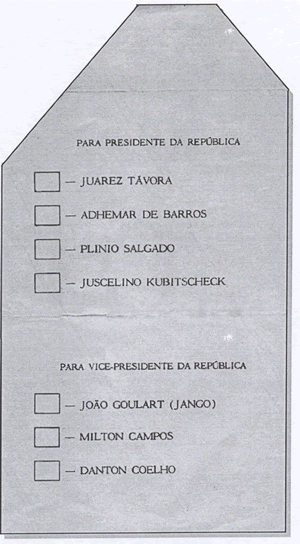
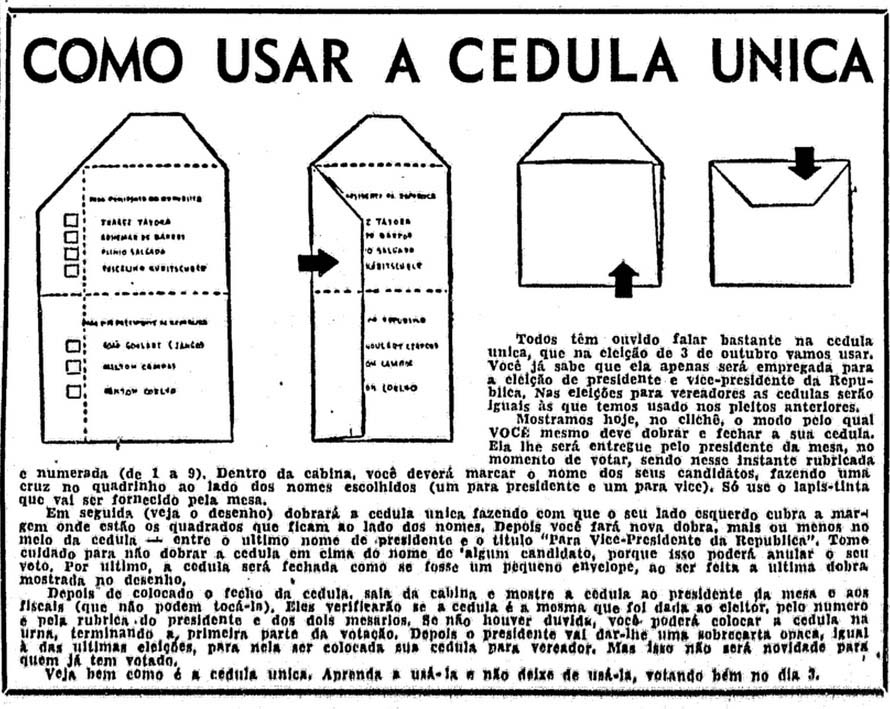
Figure 5. Top: The first official ballot used in the 1955 presidential election. Courtesy of Tribunal Superior Eleitoral Archive. Bottom: Instructions to use and fold the new ballot published by Folha da Manhã newspaper in 1955. Courtesy of Folha da Manhã.
The main challenger of PSD was UDN, which was the party of families from competing oligarchies and held a strong desire for morality and external capital. In 1955, after some years of coalition and tacit agreements, the dispute between the two parties was materialized in the UDN’s proposition to cleanse the electoral system by introducing the Australian ballot as the new official ballot.23 (Fig. 5) Here, a political will from a more “resource-constrained”24 group was about to diminish PSD’s strength through the material understanding of design in a new printed piece of paper. The Australian ballot is one of the crucial turning points in the history of voting because it embodied the value of secrecy.25 This device was so decisive for modern democracies that its features are taken for granted and are still used today: one single ballot printed with the list of all candidates is distributed to voters at the polling stations at the public’s expense. Rather than taking ballots with them, voters received the official ballot at the polling station and went into the booth, where they cast their vote in secret. In Brazil, the design of the Australian ballots varied according to different offices. For majoritarian races (such as for president, governor, senator, and mayor), a complete list of candidates was presented with small checkboxes in front of each name. Voters needed to check the box next to their choice of candidate. For proportional races (such as federal deputy, state deputy, and city councilor) with much longer lists of candidates, voters needed to write down their chosen candidate’s name. (Fig. 6)
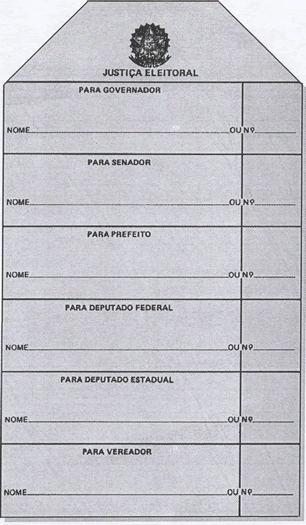
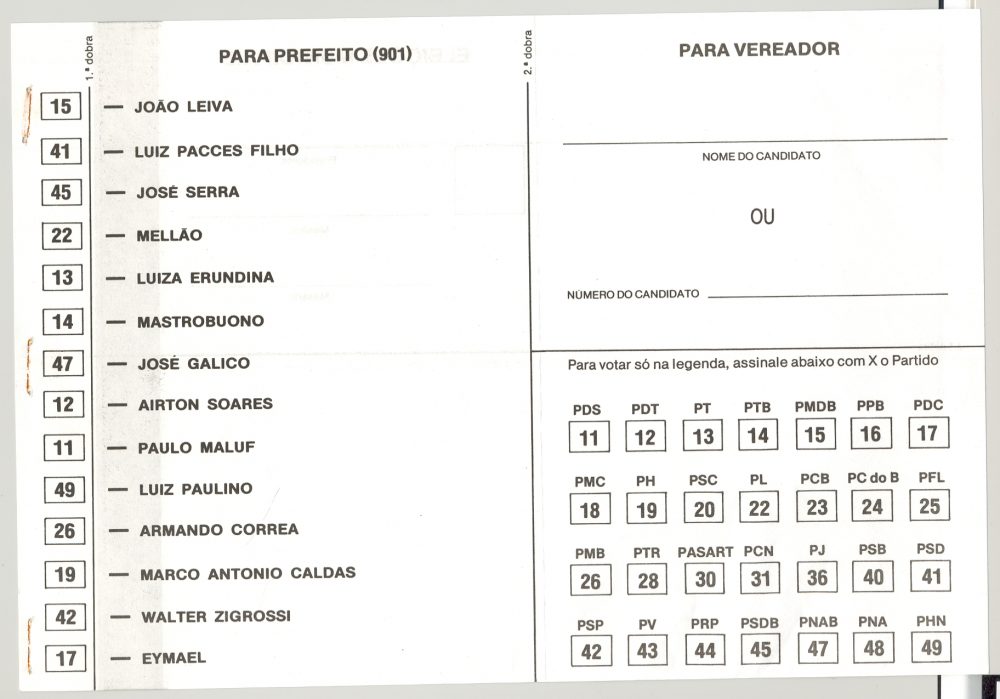
Figure 6. Top: 1982 ballot for the countryside only. Voters needed to write their candidate’s name or number in the designated space for each office. The ballot could be folded to become an envelope. Courtesy of Tribunal Superior Eleitoral Archive. Bottom: Ballot for São Paulo local elections in 1988 at the period of redemocratization. For mayor, voters could tick their candidate’s number or name. For city councilors, voters could write candidates’ names or numbers or tick their preferred party. Courtesy of Tribunal Superior Eleitoral Archive.
The adoption of this new ballot dramatically changed elections in Brazil. First, as Mahmoud Keshavarz claims, design politics includes the realm of the politics of design, which encompasses deciding who gets to be called a designer.26 The first legislative proposal from the incumbent’s party appointed the executive branch the power to design, print, and distribute the official ballots. By controlling the National Press and the Department of Post and Telegraph, the incumbent president would be able to delay printing if the elections looked to be not in their favor. Another strategy was to send fewer ballots to battlefield states, blaming “technicalities” to avoid responsibility.27 That proposal was eventually overturned, and the Electoral Justice became responsible for producing and distributing the ballots. The ballots also disciplined the parties that needed to register their candidates prior to printing standard ballots. Furthermore, by materializing vote secrecy, the Australian ballot undermined the effectiveness of local elites’ vote-brokerage and, as a consequence, eroded the power of political actors who relied on these tactics (as in the case of the PSD party).28 The process of producing voters became costlier and more difficult due to the introduction of a single material artifact with a specific design.
Once the ballots were printed and distributed, the costs that different voters needed to pay to effectively express their preferences increased. The official ballot disciplined people’s bodies, demanding literacy to read their options and the ability to choose a candidate—that is having information about those running for office, recognizing their names, and writing or marking the desired option. The design of the Australian ballot created voting restrictions in places where functional illiteracy was widespread, such as in rural Brazil or the Southern United States in the 20th century. Research suggests that the introduction of the official ballot created a massive increase in wasted votes, disenfranchising many of Brazil’s less-educated voters.29
The Electronic Voting Machine
In 1962 the official ballot was used for the first time to vote for legislative seats. Since the number of people running for offices was high, voters would have to write the names or numbers of their candidates in the designated space instead of marking a checkbox. Each legislative candidate was assigned a number by the Electoral Justice, which expanded to all candidates in the 1980s when the Tribunal Superior Eleitoral (TSE, or the Superior Electoral Court in English) randomly assigned numbers for each registered party. The numbers were added to the official ballot; however, its biggest impact was in the electronic voting machine introduced in 1996. Electronic voting was seen as a solution for eliminating fraud, particularly in the vote-counting process.30 The TSE and its technical team decided to abandon paper balloting to develop a basic electronic voting machine that was safe, low-cost, small, rustic, lightweight, easy-to-store and transport, and battery-powered.31 I invite you to simulate how to cast a vote using the machine provided by the Electoral Justice (https://www.tse.jus.br/eleicoes/eleicoes-2020/simulador-de-votacao).32 Pay attention to its design, the highlighted symbols, the numbered keyboard, and the colored keys on the bottom. See how the machine guides you throughout the voting process and how intuitive it is to cast a vote with the graphic aids and the cheat sheet on top. (Fig. 7) If you make any mistake while pressing the keys, look at how the machine responds to it. Note the order of the offices available to vote and the sounds made when your final choices are cast.

Figure 7. Electoral cheat sheet template to be printed and filled for the 2018 General Elections. Courtesy of Tribunal Superior Eleitoral Archive.
Without dropping balls, flipping levers, inserting keys, perforating forms, or sliding plates, the Brazilian electronic voting machine resembles familiar devices such as telephone keypads and ATMs.33 This number-based design resembling a phone dial system was chosen to facilitate voting for all levels of literacy and technical savvy. The electronic voting machine materializes democracy and the expansion of voting rights in Brazil.34

Figure 8. Electronic voting machine in Brazil. Courtesy of O Estado de São Paulo.
In addition to digitally entering a candidate’s number instead of writing with a pen, electronic voting machines have ushered in other changes. For the first time, voters had images to identify candidates by. (Fig. 8) The device also guides the voter through the many votes that must be cast, minimizing confusion over which paper ballot to use for each office. The machine provides feedback to voters by asking for confirmation and alerting them if a number is invalid. By demanding less from people and accommodating voter diversity, the electronic voting machine has reduced difficulties and introduced millions of new voters into the electoral process.35 On the other hand, by denoting a specific order of presenting candidates, the machine prompted new behaviors as an intended strategy from the designers to draw closer attention to legislative offices.36 Furthermore, the machine disrupted the Australian ballot model where all the candidates are shown on the same page. Instead of showing all candidates on the screen, the machine invites the voter to type their candidate’s number upfront. It demands different behavior from voters, who need to memorize the number of the candidate they wish to vote for before entering the booth. (Fig. 9) Though these features were designed by a team of technocrats, the political and material consequences are beyond their intentions.
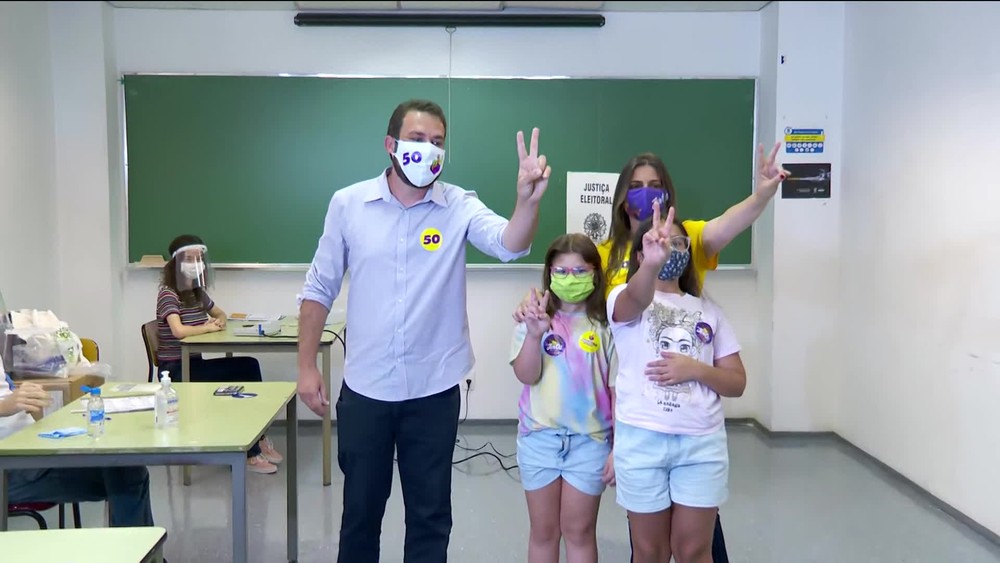
Figure 9. Candidate for Mayor of São Paolo Guilherme Boulos, and family wearing stickers and masks with his electoral number at the polling place. Courtesy of Globonews.
Furthermore, the electronic voting machine gives primacy to numbers. Candidates and parties are identified by numbers and the voter must type in the digits in order to cast their vote. This technical decision from the machine’s designers completely changed the election. This is because electoral law prohibits the use of mobile phones inside the polling booth but allows pieces of paper containing the candidate’s number, creating a new artifact—the cheat sheet—that guides the voter in the electoral process and helps them remember who they are voting for. (Fig. 10) Newspapers and even the candidates themselves provide printed templates for the voters to record their numbers (in the case of the latter, the candidate’s own number has conveniently been provided on the cheat sheet). The numbers created a new logic for campaigns; in order to be elected, candidates needed to remind potential voters of their numbers rather than their names. In every polling station, the law requires posted lists of every candidate alongside their number, though finding your candidate in the nick of time can be daunting. Thus all the campaign items need to feature this number. Campaigns come up with catchy songs with the candidate’s number repeating dozens of times in the chorus. Some candidates change their disclosed names to rhyme with their chosen numbers, others dispute with peers inside the party for having easier numbers to remember. All of this has resulted as a consequence of the design of the electronic voting machine.

Figure 10. Cheatsheet distributed by the candidate for governor of Rio de Janeiro in the 2018 elections, Eduardo Paes, filled with his electoral numbers and the numbers of candidates for other offices supported by him and his party’s coalition. Courtesy of O Globo.
Conclusion
This has been the norm for voting in Brazil since 2000, the year when the entire country transitioned to electronic voting. I remember accompanying my father to his polling station when I was a kid. He would allow me to press the numbers for his candidates and push the confirmation button at the end. Many parents include their children in the voting ritual, allowing their children to push buttons buttons and listen to beeps, perhaps in a way to get acquainted with the whole electoral performance. I have never voted any other way, and I get excited each time I press keys and cast my votes. I engage in these rituals and I play my designated role. No matter where I am considering election devices, I am fascinated by the way they embody the political climate and historical moment. Maybe I am a little frustrated that I could never experience the controversial, confusing design of the butterfly ballot used in Palm Beach County during the 2000 United States Presidential election. As the COVID-19 pandemic hit my two localities while elections unfolded in both places, new performances were created, new materialities appeared, and existing artifacts were challenged.
While elections are real and pragmatic, they are also fictional and fabricated. They result from a handful of relations between humans, places, and the artifacts we design and create to embody intangible ideals and values into things. As Clive Dilnot argued, with the crafting of devices and artifactual relations, we “remake the world” constantly.37 These three electoral devices certainly remade the world each time. Rather than viewing election devices as passive artifacts, we must recognize they act back on us and design us concurrently. The registration card, the official ballot, and the electronic voting machine show that the subtlest design choices can either suppress or enfranchise bodies. These artifacts create new systems and practices; they intentionally or unintentionally challenge (or embrace) power structures. In times when democracy is being questioned by authoritarian figures, we must understand the material culture of elections as things to think and act with in order to strengthen our democracies and respond to the calls for social justice.38 In what ways are election artifacts designing us back? What systems are they creating and in dialogue with, and for whom? Furthermore, how can we articulate (and rearticulate) electoral devices and materials to strengthen trust, participation, and democratic values?
Acknowledgements
I would like to express my deepest gratitude to Heloisa Fimiani, Rodrigo Mahlmeister, and Ligiane Alves at the Political Science Department in the University of São Paulo as well as Isabella Brandalise at the Royal Melbourne Institute of Technology. I would also like to thank Parsons MFA Trandisciplinary Design faculty Jamer Hunt, Barbara Adams, and Eduardo Stazwoski for their guidance as well as Christopher Patten from the Center for Civic Design.
Endnotes
1. Fernando Limongi, José Antônio Cheibub, and Argelina Figueiredo, “Political Participation in Brazil,” in Paths of Inequality in Brazil, ed. Marta Arretche (Cham: Springer, 2019), 4.↵
2. The Brazilian Electoral Justice is a specialized branch of the Judiciary with jurisdictional (power to judge), administrative (power to organize), and regulatory (power to elaborate norms) competencies in regards to the Brazilian electoral process. Created in 1932, it comprises the Superior Electoral Court (The TSE), 27 regional electoral courts, electoral boards, and electoral judges.↵
3. Marcia Lausen, Design for Democracy: Ballot and Election Design (Chicago: University of Chicago Press, 2007), 15.↵
4. Bruno Latour, Reassembling the Social. (Oxford: Oxford University Press, 2005), 39.↵
5. Mahmoud Keshavarz, The Design Politics of the Passport: Materiality, Immobility and Dissent, (London: Bloomsbury, 2019), 3–7.↵
6. Ibid, 132.↵
7. According to Jairo Nicolau, the first version of the title was adopted in 1875 with the name “Qualification Title.” With the Saraiva Law in 1881, the Voter Registration Title was officially created as such.↵
8. Jairo Nicolau, História do Voto no Brasil (Rio de Janeiro: Zahar, 2002), 8.↵
9. Ibid, 7.↵
10. Brasil, Tribunal Superior Eleitoral, Títulos Eleitorais: 1881-2008 (Brasília: Tribunal Superior Eleitoral, 2009), 63.↵
11. Limongi, Cheibub, Figueiredo “Political Participation in Brazil,” 3–12.↵
12. Fernando Limongi, “Fazendo Eleitores e Eleições: Mobilização Política e Democracia no Brasil Pós-Estado Novo.” Dados 58, no. 2 (2015): 372.↵
13. Limongi, “Fazendo Eleitores e Eleições,” 381.↵
14. Ibid, 371.↵
15. Ibid.↵
16. Alicia Yin Chang, This is What Democracy Looks Like: A Visual History of the Printed Ballot (Hudson: Princeton Architectural Press, 2020), 16.↵
17. The Australian ballot, also called Massachusetts ballot or secret ballot, was first introduced in Tasmania and New South Wales in the 1850s. This voting mode, as I will develop further, consists of standardized ballots listing all candidates in a nonpartisan layout distributed at the polling place.↵
18. Brasil, Congresso Nacional, “Lei no. 1.164, de 24 de julho de 1950.”↵
19. Nicolau, História do Voto no Brasil, 26.↵
20. Chang, This is What Democracy Looks Like, 25.↵
21. Limongi, “Fazendo Eleitores e Eleições,” 371–400.↵
22. Lucia Hippolito, De Raposas e Reformistas: o PSD e a Experiência Democrática Brasileira, 1945–1964 (Rio de Janeiro: Paz e Terra, 1985): 37–83.↵
23. Limongi, Cheibub and Figueiredo, “Political Participation in Brazil,” 12–17.↵
24. Kimuli Kasara and Isabela Mares, “Unfinished Business: The Democratization of Electoral Practices in Britain and Germany.” Comparative Political Studies 50, no. 5 (2017), 659. ↵
25. Daniel W. Gingerich, “Ballot Reform as Suffrage Restriction: Evidence from Brazil’s Second Republic,” American Journal of Political Science 63, no. 4 (2019): 921.↵
26. Keshavarz, The Design Politics of the Passport, 3–7.↵
27. Juscelino Kubitschek de Oliveira, Meu Caminho Para Brasília: A Escalada Política. (Rio de Janeiro: Bloch, 1976), 395.↵
28. Gingerich, “Ballot Reform as Suffrage Restriction,” 929.↵
29. Ibid, 933.↵
30. Jairo Nicolau, “Impact of Electronic Voting Machines on Blank Votes and Null Votes in Brazilian Elections in 1998,” Brazilian Political Science Review 9, no. 3 (2015), 4.↵
31. Brasil. Tribunal Superior Eleitoral. Urna Eletrônica : 20 Anos a Favor da Democracia (Brasília: Tribunal Superior Eleitoral, 2016), 17.↵
32. The TSE provides a simulator on its website so that voters can train and familiarize themselves with the electronic voting process before each election. The link provided in the article leads to the 2020 Election Vote Simulation and can be accessed in Portuguese only.↵
33. Chang, This is What Democracy Looks Like, 39.↵
34. Thomas Fujiwara, “Voting Technology, Political Responsiveness, and Infant Health: Evidence From Brazil,” Econometrica 83, no. 2 (2015), 424.↵
35. Ibid, 428.↵
36. Nicolau, “Impact of Electronic Voting Machines,” 18.↵
37. Clive Dilnot, “The Artificial and What it Opens Towards,” in Design and the Question of History, ed. Tony Fry, Clive Dilnot, and Susan Stewart, (London: Bloomsbury Academic, 2014): 189.↵
38. Joachim Halse and Laura Boffi, “Design Interventions as a Form of Inquiry,” in Design Anthropological Futures, eds. Charlotte R Smith et al. (London: Taylor & Francis Group, 2016), 96.↵
Author Affiliations
Lucas Teixeira Vaqueiro is a graduate student in the MFA Transdisciplinary Design program at Parsons School of Design.

 DESIGN STUDIES BLOG
DESIGN STUDIES BLOG

